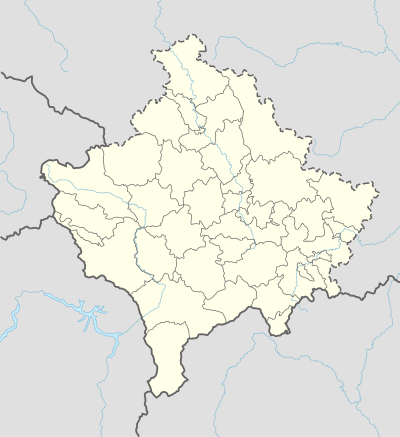Leočina
Leočina (Serbian Cyrillic: Леочина, Albanian: Leçinë) is a settlement in the Skenderaj municipality in Kosovo.[lower-alpha 1] The rural settlement lies on a cadastral area with the same name, of 784 hectares. It lies 702 m over sea level. The village has an Albanian majority and Serbian minority; in the 1991 census, it had 1069 inhabitants.
Leçinë | |
|---|---|
Village | |
 Leçinë Location in Kosovo | |
| Coordinates: | |
| Location | |
| District | Mitrovicë |
| Municipality | Skënderaj |
| Elevation | 702 m (2,303 ft) |
| Population (2011)[1] | |
| • Total | 941 |
| Time zone | UTC+1 (CET) |
| • Summer (DST) | UTC+2 (CEST) |
Geography
It lies in the hilly region of Drenica.
History
It is mentioned for the first time in a charter of Serbian King Stephen Milutin (r. 1282–1321), dating to 1314. It is mentioned in an Ottoman defter (tax register) of 1485, as a great village, divided in an upper and lower oblast, with a total of 62 Serb houses, and two Orthodox priests.
The Church of St. John, which lies on the cemetery, was built in the village in the 14th century, and reconstructed in the 16th century.[2] Until latter the half of the 19th century it was known as the Church of St. Nicholas.[2] It was expertly conserved and reconstructed in 1967 and is protected by the Republic of Serbia.[2] There exist remains of another 14th-century church, the so-called "Kaluđerska-" or "Preobraška crkva"[2] and one more church, a total of three.[2]
On the night of May 19, 1998, members of the Albanian Kosovo Liberation Army kidnapped Dostan Šmigić (aged 41), a worker in the institute for labour market in Skenderaj, on the Čitak-Leočina road and took him to an unknown location.[3]
| Ethnic group | 1948 | 1953 | 1961 | 1971 | 1981[4] | 1991 |
|---|---|---|---|---|---|---|
| Albanians | 875 | |||||
| Serbs | 119 | |||||
| Total[5] | 511 | 547 | 652 | 841 | 994 | 1069 |
Notes
- Kosovo is the subject of a territorial dispute between the Republic of Kosovo and the Republic of Serbia. The Republic of Kosovo unilaterally declared independence on 17 February 2008, but Serbia continues to claim it as part of its own sovereign territory. The two governments began to normalise relations in 2013, as part of the 2013 Brussels Agreement. Kosovo is currently recognized as an independent state by 97 out of the 193 United Nations member states. In total, 112 UN member states recognized Kosovo at some point, of which 15 later withdrew their recognition.
References
- 2011 Kosovo Census results
- Antonije Isaković, Kosovsko-metohijski zbornik, SANU, 1990, p. 101: "Леочина"
- Ilustrovana Politika, Broj 2054, 30. maj 1998. Dnevnik od 19. do 24. maja Archived 2009-01-03 at the Wayback Machine
- 1981 Census, Kosovo Archived 2012-03-17 at the Wayback Machine (Preliminary)
- Kosovo censuses 1948-1991
Sources
- "Преобрашка-Калуђерска црква". Споменици културе у Србији.
- "Црква Св. Јована". Споменици културе у Србији.
- Tatomir Vukanović, Drenica: The Second Serbian Holy Mountain, III Edition, Public and University Library "Ivo Andrić" (Priština), Mnemosyne Center, Belgrade 2005; anthropogeographical and ethnological field research conducted by ethnologist Tatomir Vukanović (1907-1997) between 1934 and 1937.